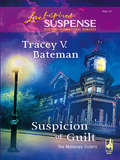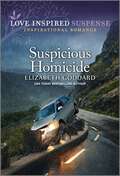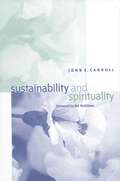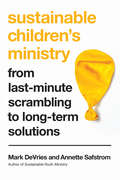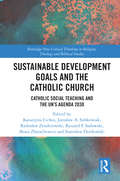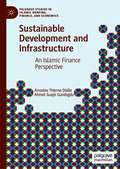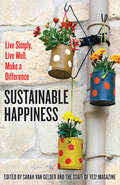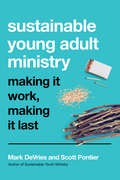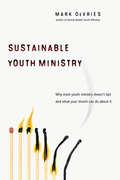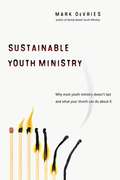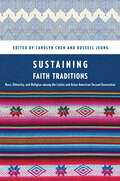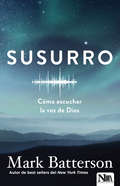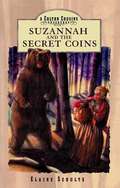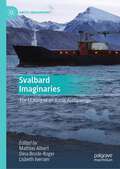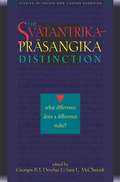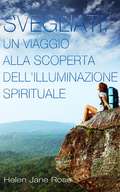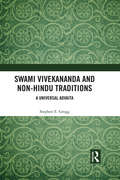- Table View
- List View
Suspicion of Guilt
by Tracey V. BatemanTheft, flood, fire--someone was trying to destroy the home for troubled girls that Denni Mahoney had worked so hard to build. It was obvious her neighbors didn't want them around, but could the girls' pasts be the source of even greater menace?As the detective on the case, Reece Corrigan had to figure out what was going on at Mahoney House--and keep the unnervingly attractive Denni safe. And though the attacks hadn't been successful, Reece feared it was only a matter of time before the perpetrator's focus shifted from the house...to Denni herself.
Suspicious Homicide (Honor Protection Specialists #4)
by Elizabeth GoddardThe mountains are full of secrets… Uncovering them could be deadly When Finnley Wilbanks is run off a mountainside road, it confirms her worst fears—her father was murdered. With her life hanging in the balance, she turns to bodyguard and investigator Caine Honor for protection. As they work together to solve the mystery behind her father&’s death, danger stalks their every move. And keeping Finnley alive long enough to find answers might be Caine&’s hardest mission yet.From Love Inspired Suspense: Courage. Danger. Faith.Honor Protection Specialists Book 1: High-Risk RescueBook 2: Perilous Security DetailBook 3: Deadly SabotageBook 4: Suspicious Homicide
Suspicious Minds: A Novel
by Christy BarrittRock and roll may never die, but the King is definitely dead . . . again. To pay off some bills, crime scene cleaner Gabby St. Claire takes a job doing mold remediation, but she finds a surprise in the dilapidated home's crawlspace: Elvis, dead as a doornail and still wearing his blue suede shoes. How could she possibly keep her nose out of a case like this? A sequel to the popular novel Hazardous Duty.
Sustainability and Spirituality
by John E. CarrollThis groundbreaking book explores the inherent interconnectedness of sustainability and spirituality, acknowledging the dependency of one upon the other. John E. Carroll contends that true ecological sustainability, in contrast to the cosmetic attempts at sustainability we see around us, questions our society's fundamental values and is so countercultural that it is resisted by anyone without a spiritual belief in something deeper than efficiency, technology, or economics. Carroll draws on the work of cultural historian and "geologian" Thomas Berry, whose eco-spiritual thought underlies many of the sustainability efforts of communities described in this book, including particular branches of Catholic religious orders and the loosely organized Sisters of the Earth. The writings of Native Americans on spirituality and ecology are also highlighted. These models for sustainability not only represent the tangible link between ecology and spirituality, but also, more importantly, a vision of what could be.
Sustainability and the Humanities
by Walter Leal Filho Adriana Consorte McCreaThis book explores the strong links between sustainability and the humanities, which go beyond the inclusion of social sciences in discussions on sustainability, and offers a holistic discussion on the intellectual and moral aspects of sustainable development. The contributions from researchers in the fields of education, social sciences, religion, humanities, and sustainable development fulfill three main aims:They provide university lecturers interested in humanities and sustainable development with an opportunity to present their work;foster the exchange of information, ideas and experiences acquired in the execution of teaching and research; anddiscuss methodological approaches and projects that provide a better understanding of how the humanities can contribute to the debate on sustainable development. Prepared by the Inter-University Sustainable Development Research Programme and the World Sustainable Development Research and Transfer Centre, the book reiterates the need to promote integrated approaches to sustainable development. Including practice-based lessons learnt that can be replicated further, it is a valuable resource for scientists and practitioners working in the humanities and sustainable development.
Sustainable Children's Ministry: From Last-Minute Scrambling to Long-Term Solutions
by Mark DeVries Annette SafstromSustainable Children’s Ministry
Sustainable Development Goals and the Catholic Church: Catholic Social Teaching and the UN’s Agenda 2030 (Routledge New Critical Thinking in Religion, Theology and Biblical Studies)
by Ski Katarzyna Cichos Stanis 322 Jaros 322 Aw A. Sobkowiak Ryszard F. Sadowski Beata Zbarachewicz Rados 322 Aw Zenderowski Aw Dzieko 324This book identifies both the consistencies and disparities between Catholic Social Teaching and the United Nation’s (UN) Sustainable Development Goals (SDGs). With Pope Francis’ Laudato si’ encyclical, Catholicism seems to be engaging more than ever with environmental and developmental concerns. However, there remains the question of how these theological statements will be put into practice. The ongoing involvement of the Catholic Church in social matters makes it a significant potential partner in issues around development. Therefore, with the use of the comparative method, this book brings together authors from multiple disciplines to assess how the political and legal aspects of each of the UN’s 17 SDGs are addressed by Catholic Social Teaching. Chapters answer the question of how the Catholic Church evaluates the concept of sustainable development as defined by the Agenda 2030 Goals, as well as assessing how and if it can contribute to shaping the contemporary concept of global development. Examining the potential level of cooperation between the international community and the Catholic Church in the implementation of the Agenda 2030 Goals, this volume will be of keen interest to scholars of Catholic Studies, Religious Studies and the Sociology of Religion, as well as Environmental Studies and Development Studies.
Sustainable Development and Infrastructure: An Islamic Finance Perspective (Palgrave Studies in Islamic Banking, Finance, and Economics)
by Ahmet Suayb Gundogdu Amadou Thierno DialloMost books on Islamic finance and development issues are written from an academic perspective. Although academic reflection is key for future direction, dissatisfaction with previous development efforts, as evidenced by their lack of sustainability, suggests the need for a different type of review. Development work is complex and requires a detailed and transparent approach in order to ensure a cogent resolution for potential long-term issues. Each intervention area requires specific elaboration for meaningful impact. The perfect solution for one sector might be detrimental for another. Islamic finance, with its strict Riba restrictions, rules, and other checks and balances, is a good fit for infrastructure development in pursuit of sustainable development. When it comes to sustainable development, this book argues, Islamic finance has the tools to intervene for maximum impact. However, the issue of sustainability is not only related to Islamic finance; more policy discourse is needed. This requires guidance from the principles of Islamic economics, as well. This book discusses infrastructure development vis-à-vis sustainable development, drawn from decades of real-life development banking experience, and proposes impactful intervention methods based on wisdom from Islamic economics and finance.
Sustainable Happiness: Live Simply, Live Well, Make a Difference
by Sarah Van GelderWe're bombarded by messages telling us that bigger and better things are the keys to happiness—but after we pile up the stuff and pile on the work hours, we end up exhausted and broke on a planet full of trash. Sarah van Gelder and her colleagues at YES! Magazine have been exploring the meaning of real happiness for eighteen years. Here they offer fascinating research, in-depth essays, and compelling personal stories by visionaries such as Annie Leonard, Matthieu Ricard, and Vandana Shiva, showing us that real well-being is found in supportive relationships and thriving communities, opportunities to make a contribution, and the renewal we receive from a thriving natural world. In the pages of this book, you'll find creative and practical ways to cultivate a happiness that is nurturing, enduring, and life affirming.
Sustainable Young Adult Ministry: Making It Work, Making It Last
by Mark DeVries Scott PontierYoung adult ministry scares us.programsSustainable Young Adult Ministry
Sustainable Youth Ministry: Why Most Youth Ministry Doesn't Last and What Your Church Can Do About It
by Mark DeVrieshelps senior pastors and search committees create a realistic job description for a youth pastorprovides tips for making wise hiring decisionsequips youth pastors to build a strong volunteer teamoffers creative solutions to help youth pastors set and keep boundariesgives a road map for navigating church politicsand morecan
Sustainable Youth Ministry: Why Most Youth Ministry Doesn't Last and What Your Church Can Do About It
by Mark DevriesYou're looking for a youth pastor. Again. What goes wrong? Why do youth ministries crumble? And what is the cost to students, parents, volunteers and church staff?Is a sustainable youth ministry possible, even after a youth pastor leaves?Youth ministry expert Mark DeVries knows the answer is yes, because he helps build sustainable youth ministries through his coaching service called Youth Ministry Architects. So take heart: No matter what state the youth ministry at your church is in--in need of a leader and volunteers, full of battles and stress, large or small in number--it can be built to survive and to last for the long haul. Based on his own experience and on his many conversations and interviews with churches in crisis, DeVries pinpoints problems that cause division and burnout and dispels strongly held myths. He then provides the practical tools and structures pastors and church leaders need to lay a strong foundation for your ministry so that it isn't built on a person or the latest, greatest student ministry trend. His accessible guidancehelps senior pastors and search committees create a realistic job description for a youth pastorprovides tips for making wise hiring decisionsequips youth pastors to build a strong volunteer teamoffers creative solutions to help youth pastors set and keep boundariesgives a road map for navigating church politicsand moreBuilding a sustainable youth ministry is not easy, and it's not quick. But with commitment to the process, hard work and DeVries's guidance, you can put together a healthy youth ministry--one that fits your church and lasts for the long haul. Youth ministrycanlast. Here's how.
Sustaining Faith Traditions: Race, Ethnicity, and Religion among the Latino and Asian American Second Generation
by Carolyn Chen Russell JeungOver fifty years ago, Will Herberg theorized that future immigrants to the United States would no longer identify themselves through their races or ethnicities, or through the languages and cultures of their home countries. Rather, modern immigrants would base their identities on their religions.The landscape of U.S. immigration has changed dramatically since Herberg first published his theory. Most of today’s immigrants are Asian or Latino, and are thus unable to shed their racial and ethnic identities as rapidly as the Europeans about whom Herberg wrote. And rather than a flexible, labor-based economy hungry for more workers, today’s immigrants find themselves in a post-industrial segmented economy that allows little in the way of class mobility.In this comprehensive anthology contributors draw on ethnography and in-depth interviews to examine the experiences of the new second generation: the children of Asian and Latino immigrants. Covering a diversity of second-generation religious communities including Christians, Hindus, Buddhists, Muslims, and Jews, the contributors highlight the ways in which race, ethnicity, and religion intersect for new Americans. As the new second generation of Latinos and Asian Americans comes of age, they will not only shape American race relations, but also the face of American religion.
Susurro: Cómo escuchar la voz de Dios
by Mark Batterson¿Habla Dios todavía? ¿De que maneras? Es cierto que en la antigüedad, y de las formas más misteriosas, Dios le habló a Su pueblo. Pero ¿sigue hablándonos hoy? Mark Batterson por cierto lo cree. Y quiere presentarte los siete lenguajes del amor que Dios emplea, cada uno de ellos enteramente divino, y único. El susurro de Dios puede responder a tus preguntas más calientes, calmar tus miedos más oscuros y concretar tus sueños más grandes. ¡Descubre lo simple que es oír la voz de Dios en cada uno de los aspectos de tu vida! Él está hablando. ¡Asegúrate de saber cómo escuchar!
Suturing Life Along the Way: Poetical Writings
by Paul MobleyFrom the author: Living life means that we are continually adding to it what we hope are good things. We also remove things we do not like. Thus, suturing refers to that continual effort during our life. These poetical-type writings reveal events along the way of life that the reader can relate to.
Suzannah Strikes Gold (Colton Cousins Adventure Ser. #2)
by Elaine L. Schulte"Gold! It's real gold!" Suzannah Colton can’t wait to get to California. The whole wagon train is buzzing about the great Gold Rush, and she hopes to strike it rich! But first the Coltons have to brave the last leg of the journey-over the treacherous Sierra Nevada mountains. With her brother-in-law gone, Suzannah must drive the oxen and care for her sister. Suzannah learns to trust in God through the difficult days. But her faith turns to greed when she discovers gold for herself. And then the real danger begins... Look for other books in the Colton Cousins Adventure series. Combining exciting adventure, historical accuracy, and Christian principles, this is a series both boys and girls will love. ELAINE SCHULTE is the author of Suzannah and the Secret Coins and Daniel Colton Under Fire. She is married, has two sons, and lives in Rancho Santa Fe, California. Ages 8-12
Suzannah and the Secret Coins (A Colton Cousins Adventure Ser. #1)
by Elaine L. SchulteIn 1848 twelve-year-old Suzannah and her cousin Daniel travel with their families from the East Coast along the National Road, also known as the Cumberland Road, to the Missouri frontier, and a blizzard, bear chase, and other dangers along the way make them glad to have God's strength on their side.
Svalbard Imaginaries: The Making of an Arctic Archipelago (Arctic Encounters)
by Mathias Albert Lisbeth Iversen Dina Brode-RogerBy drawing on a broad range of disciplinary backgrounds, this book illustrates the immense complexities of Svalbard as a place, point of reference, or social concept. It portrays the multiple, situated perspectives that characterize understandings and imaginings of Svalbard, and brings together contributions from academic fields that rarely interact with each other.Svalbard Imaginaries contributes to a number of research contexts, ranging from a broadly conceived, multi-disciplinary field of ‘Arctic Studies’ to more disciplinary specific debates on how places are reworked at the interstices of various global flows and vice versa. It assembles contributions on imaginaries that cover a wide array of issues, including—but not limited to—Svalbard as a geopolitical site, a landscape, an image, a (mining) heritage assemblage, a tourist destination, a wilderness, a built environment, a site of knowledge production, a site of artistic engagement, and projections of the future. It deliberately assembles analyses that refer to a variety of timescales and covers representations of the past, the present, and possible futures of Svalbard.
Svatantrika-Prasangika Distinction
by Georges B.J. Dreyfus L. Sara McclintockMadhyamaka, or "Middle Way," philosophy came to Tibet from India and became the basis of all of Tibetan Buddhism. The Tibetans, however, differentiated two streams of Madhyamaka philosophy--Svatantrika and Prasangika. In this collection, leading scholars in the field address the distinction on various levels, including the philosophical import for both Indian and Tibetan Madhyamaka and the historical development of the distinction itself.
Svegliati. Un viaggio alla scoperta dell'illuminazione spirituale.
by Helen Jane Rose Annarita TranficiEstratto della recensione di Nandita Keshavan (5 stelle) “Svegliati. Un viaggio alla scoperta dell'illuminazione spirituale” è un libro che contiene una serie di messaggi chiari e coerenti che vi aiuteranno ad aprirvi alla felicità interiore e alla spiritualità. I messaggi sono profondamente filosofici ed enfatizzano l’importanza del cambiamento, della continua evoluzione verso una maggiore consapevolezza di sé e della scoperta della pace e della forza interiore attraverso il distacco dalle illusioni e l’unione con il proprio spirito. È un messaggio forte, chiaro, che intende offrire conforto. L’autrice ha incluso molte citazioni e frasi di personaggi famosi che aggiungono valore ai temi centrali del libro, ovvero: come creare un futuro migliore per noi stessi e le nuove generazioni, come essere dei modelli migliori per i nostri bambini, come imparare a credere nel cambiamento e a sfuggire l’inganno di massa e il controllo che gli altri esercitano su di noi. Credo fermamente nella validità delle affermazioni qui presentate e anche nel valore del quadro generale qui descritto. È una lettura utile e che consiglierei non solo alle persone che approcciano per la prima volta il pensiero spirituale e sono interessate ad approfondirne i concetti essenziali, ma anche a coloro che hanno una certa familiarità con le nozioni più comuni. Lo stile della scrittura è intriso di fiducia, sincerità e realismo. Credo che grazie a questo libro, molte persone inizieranno a riflettere sulle proprie abitudini e percezioni e scoprire le verità che sono nascoste dentro di loro. Sono presenti, infatti, moltissimi spunti di riflessione che aiutano a capire come ritrovare la serenità, su quali criteri definire il nostro successo, come rispettare gli altri e il pianeta in cui viviamo e come accelerare la nostra evoluzione interiore. *Il libro è pubblicato in formato e-book e cartaceo.
Swami Chidananda Saraswati
by Shivanand Adhrvyuસ્વામી ચિદાનંદ સરસ્વતી એ નવજીવન દ્વારા પ્રકાશિત સંતવાણી ગ્રંથાવલિનું અટ્ઠાવીસમું પુસ્તક છે. સંતવાણી ગ્રંથાવલિ એ ભારતના મહાનુભાવોના જીવન અને વિચારને વાચક સુધી પહોંચાડવાનો નવજીવન ટ્રસ્ટનો નમ્ર પ્રયાસ છે.
Swami Muktanand
by Shri Jamanalal J. Halatwalaસ્વામી મુક્તાનંદ એ નવજીવન દ્વારા પ્રકાશિત સંતવાણી ગ્રંથાવલિનું છવ્વીસમું પુસ્તક છે. સંતવાણી ગ્રંથાવલિ એ ભારતના મહાનુભાવોના જીવન અને વિચારને વાચક સુધી પહોંચાડવાનો નવજીવન ટ્રસ્ટનો નમ્ર પ્રયાસ છે.
Swami Shivananda Saraswati
by Shivanand Adhrvyuસ્વામી શિવાનંદ સરસ્વતી (હૃષીકેશ) એ નવજીવન દ્વારા પ્રકાશિત સંતવાણી ગ્રંથાવલિનું સત્તાવીસમું પુસ્તક છે. સંતવાણી ગ્રંથાવલિ એ ભારતના મહાનુભાવોના જીવન અને વિચારને વાચક સુધી પહોંચાડવાનો નવજીવન ટ્રસ્ટનો નમ્ર પ્રયાસ છે.
Swami Vivekananda
by Shri Swami Adhyatmanand Sarswatiસ્વામી વિવેકાનંદ એ નવજીવન દ્વારા પ્રકાશિત સંતવાણી ગ્રંથાવલિનું તૃતીય પુસ્તક છે. સંતવાણી ગ્રંથાવલિ એ ભારતના મહાનુભાવોના જીવન અને વિચારને વાચક સુધી પહોંચાડવાનો નવજીવન ટ્રસ્ટનો નમ્ર પ્રયાસ છે.
Swami Vivekananda and Non-Hindu Traditions: A Universal Advaita
by Stephen E. GreggThe Hindu thinker Swami Vivekananda (1863-1902) was and remains an important figure both within India, and in the West, where he was notable for preaching Vedanta. Scholarship surrounding Vivekananda is dominated by hagiography and his (mis)appropriation by the political Hindu Right. This work demonstrates that Vivekananda was no simplistic pluralist, as portrayed in hagiographical texts, nor narrow exclusivist, as portrayed by some modern Hindu nationalists, but a thoughtful, complex inclusivist. The book shows that Vivekananda formulated a hierarchical and inclusivistic framework of Hinduism, based upon his interpretations of a four-fold system of Yoga. It goes on to argue that Vivekananda understood his formulation of Vedanta to be universal, and applied it freely to non-Hindu traditions, and in so doing, demonstrates that Vivekananda was consistently critical of ‘low level’ spirituality, not only in non-Hindu traditions, but also within Hinduism. Demonstrating that Vivekananda is best understood within the context of ‘Advaitic primacy’, rather than ‘Hindu chauvinism’, this book will be of interest to scholars of Hinduism and South Asian religion and of South Asian diaspora communities and religious studies more generally.
